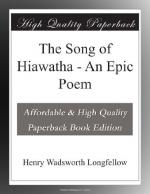|
This section contains 2,166 words (approx. 8 pages at 300 words per page) |

|
SOURCE: “Longfellow's Motives for the Structure of Hiawatha,” in American Literature, Vol. 42, No. 4, January, 1971, pp. 548-53.
In the following essay, Tichi contends The Song of Hiawatha was inspired by Longfellow's desire to provide “cultural continuity between the old world and the new.”
The critical disesteem of Longfellow's verse hallmarks was perhaps a certainty upon the decline of the poet's inflated reputation shortly after his death in 1882. Despite Edward Wagenknecht's sympathic mid-twentieth-century reappraisal of Longfellow through biography, and Newton Arvin's more recent effort to establish him without apology as a minor figure in American literature, still it is quite likely that few readers yet confront a poem like Hiawatha with an attitude approaching disinterested openness. Howard Nemerov, for one, assures us he cannot, having “between the halves of a football game … heard great swatches of Hiawatha droned out over the public address system while several hundred drum-majorettes twirled their...
|
This section contains 2,166 words (approx. 8 pages at 300 words per page) |

|


